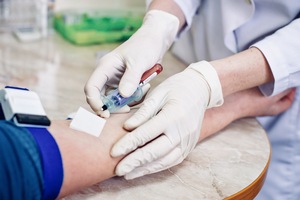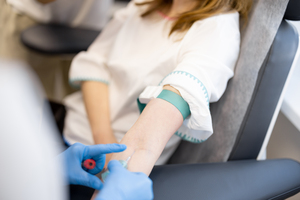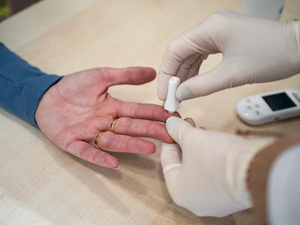Hair Loss Treatment
Hair loss treatment can help restore and thicken balding and thinning hair. It can also help you feel more confident about your appearance. Use Solv to find a dermatologist or skin care doctor near you and get one step closer to receiving quality hair loss treatment.
All about hair loss treatment
Hair loss can be treated in various ways, such as with medication, transplant surgery, and laser therapy. According to the American Academy of Dermatology (AAD), effective treatment for hair loss begins with finding the root cause. Dermatologists usually have the experience and training needed to identify the underlying cause of hair loss.
During your initial appointment, your dermatologist will usually ask you a series of questions to learn more about your hair loss, such as when it started and the rate at which your hair fell out. Then, your dermatologist will perform a physical exam that involves inspecting your scalp, nails, and other areas affected by hair loss, says the AAD. Your dermatologist may also test the health of your hair, such as by pulling on it gently to see how easily it breaks.
In some instances, your dermatologist may perform a blood test or biopsy to confirm or rule out conditions causing your hair loss. For example, hormone imbalances, vitamin deficiencies, and infections are potential root causes of hair loss, reports the AAD. After identifying the cause of your hair loss, your dermatologist can discuss your available treatment options.
Treatment
According to the AAD, hair loss can be treated either at home or at your dermatologist’s office based on your chosen method. Some hair loss treatments may work better for you than for others. You may need to try multiple treatments before finding the one that works best for you.
Medication
Finasteride and spironolactone are common medications used to treat hair loss.
Finasteride is a hair loss treatment for men, says the AAD. It can slow down hair loss and stimulate the growth of new hair. It comes as a pill taken once a day and produces results after about four months.
Spironolactone is a hair loss treatment for women that can stop further hair loss and increase hair thickness. The AAD adds that this medication is effective in approximately 40% of women who take it to treat female-pattern hair loss.
Your dermatologist can talk to you about other medications approved for treating thinning hair in men and women.
Hair transplant surgery
During hair transplant surgery, hairs get moved from an area of thick growth to bald areas, reports the National Institutes of Health (NIH).
First, local anesthesia is used to numb the area of your scalp to be treated. Then, your dermatologist or skin care doctor will make a series of tiny cuts in balding areas where hairs will be transplanted. Healthy hairs taken from other areas will be carefully placed inside each of these cuts.
According to the NIH, hair transplant surgery is usually a permanent solution for hair loss.
Laser therapy
Low-level laser therapy can help stimulate hair regrowth, says the AAD. It may be used to treat hereditary hair loss or hair loss that has occurred due to cancer treatments like chemotherapy. The AAD adds that laser therapy for hair loss is safe and painless, though you may need several treatments over several months to see results.
Lifestyle and home remedies
Hair loss can sometimes be caused by certain lifestyle behaviors. Poor diet, chronic stress, drug use, and certain hairstyles are some of many factors that can cause hair loss, reports the NIH. Modifying lifestyle behaviors that contribute to hair loss may prevent you from losing additional hair and may even promote hair regrowth.
Lifestyle changes that may treat hair loss, according to the AAD and NIH, include:
- Changing your hairstyle, such as avoiding tight ponytails that cause hair to break.
- Taking nutritional supplements that support hair growth, such as zinc, biotin, and iron.
- Shampooing hair less often.
- Allowing hair to air-dry, as opposed to using a hairdryer.
- Stopping hair-pulling when nervous.
- Wearing wigs, hair weaves, or hairpieces.
- Losing excess weight.
Find Hair Loss Treatment near you
- Alabama
- Alaska
- Arizona
- Arkansas
- California
- Colorado
- Connecticut
- Delaware
- Florida
- Georgia
- Hawaii
- Idaho
- Illinois
- Indiana
- Iowa
- Kansas
- Kentucky
- Louisiana
- Maine
- Maryland
- Massachusetts
- Michigan
- Minnesota
- Mississippi
- Missouri
- Montana
- Nebraska
- Nevada
- New Hampshire
- New Jersey
- New Mexico
- New York
- North Carolina
- North Dakota
- Ohio
- Oklahoma
- Oregon
- Pennsylvania
- Rhode Island
- South Carolina
- South Dakota
- Tennessee
- Texas
- Utah
- Vermont
- Virginia
- Washington
- Washington DC
- West Virginia
- Wisconsin
- Wyoming
Hair Loss Treatment FAQs
Why do people experience hair loss?
Hair loss can be caused by a wide range of factors, including heredity, physical or emotional stress, and hormonal imbalances, says the NIH. The AAD adds that a dermatologist or skin care doctor can usually help you identify the cause of your hair loss by performing a physical exam along with a blood test or scalp biopsy.
What are the different types of hair loss?
Hair loss falls into several categories, reports Harvard University. Telogen effluvium is a common type of hair loss that occurs two to three months after major body stress, such as a prolonged illness or major surgery. Alopecia areata is an autoimmune disease that causes hair to fall out in one or more small patches. Hereditary pattern baldness is the most common type of hair loss, adds Harvard University, and can begin at any time in a man’s life, including during his teen years.
Are there any non-surgical hair replacement options?
According to the AAD, wigs, hairpieces, hair weaves, and hair extensions are all non-surgical hair replacement options. However, many non-surgical treatments can stimulate hair regrowth instead of replacing it with hair plugs or healthy hairs from other parts of your body. Laser therapy, medications, and microneedling are all non-surgical treatments for hair loss. Your dermatologist can talk to you in greater detail regarding a non-surgical baldness cure.
Does hair transplant surgery result in permanent growing hair?
According to the NIH, hair transplant surgery usually results in excellent hair growth within several months after your procedure, though more than one treatment session may be needed to achieve the best results. The NIH adds that the replaced hairs are mostly permanent and that no long-term care is needed. Your dermatologist can determine whether hair transplant surgery is ideal for you based on the cause and degree of your hair loss.
Will hair transplant surgery restore my original hair density?
The transplanted hair may not look as great as you had hoped and desired, reports the NIH. This procedure may not restore your original hair density, though it may improve the appearance of balding and thinning hair. Your dermatologist or skin care doctor can talk to you in greater detail about what this surgery can and cannot accomplish for you based on the degree of your balding.
What should I take for hair loss?
Finasteride and spironolactone are two medications approved by the FDA for hair loss. Finasteride can promote hair growth for men and can also slow down the rate of hair loss. Spironolactone can stop further hair loss in women and increase hair thickness. Ask your dermatologist for more information about medications approved for hair loss treatment.
Where can I get hair loss treatment near me?
Type “hair loss treatment near me” or “dermatologist near me” into your search engine to locate nearby skin care doctors in your area who perform hair loss treatments. Better yet, use Solv to find top-rated dermatologists in your area who offer this service. Solv makes it easy to find and contact high-quality healthcare providers in your area and make appointments directly from its website.
Solv has strict sourcing guidelines and relies on peer-reviewed studies, academic research institutions, and medical associations. We avoid using tertiary references.
Everyday Healthcare, Simplified
Expert advice to help you live your best life








